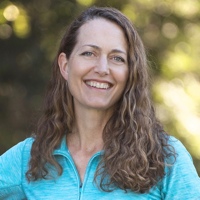[Editor’s Note: This article was written by guest contributor Sarah Lavender Smith, who first met Paul Charteris in 2009 and who ran the 2015 Tarawera Ultramarathon.]
Shortly after 9 p.m., more than 15 hours into the 100-kilometer Tarawera Ultramarathon on the lush North Island of New Zealand, Paul Charteris ran silently yet steadily toward the final aid station.
Head down, stride shortened, his heavyset six-foot, three-inch frame hunched forward while his arms swung and hands clutched a pair of water bottles. His slack jaw and furrowed brow transformed his normally smiling mouth and merry eyes into a mask of exhaustion and determination.
“He was basically a zombie, just so in his own world,” recalls his friend and pacer, iRunFar’s own Bryon Powell, one of four supporters who ran next to Paul on that February 7th night. “It was the exact opposite of the outgoing Paul you see on a daily basis.”
Like many runners in the crowd, Charteris wore a red shirt that said High Five-O Challenge, a signal of his support for a challenge initiated by his friend Malcolm Law to raise money for the Mental Health Foundation of New Zealand by running 50 mountain marathons in 50 days. Over the past year, Charteris had become more open about his personal struggle with depression and his passion for the cause of mental health, so the t-shirt perhaps had a deeper meaning than mere support of his friend’s project.
He had a little more than three miles left to complete an odyssey that was much longer and more arduous than the 62 miles of this race—his race, which he launched seven years earlier but until now had never run himself.
The challenging journey that brought Charteris, 43, to this point stretched from New Zealand to California and back, spanning more than a decade.
Inner demons and natural disasters tried to knock him off course along the way. Poverty, injury, failure, depression, fires, and even a cyclone all played a part in his ultramarathon crescendo.
Approaching the aid station, Charteris and his friends came upon a hand-lettered sign that read: “Look what you started, Paul. It’s so awesome.”
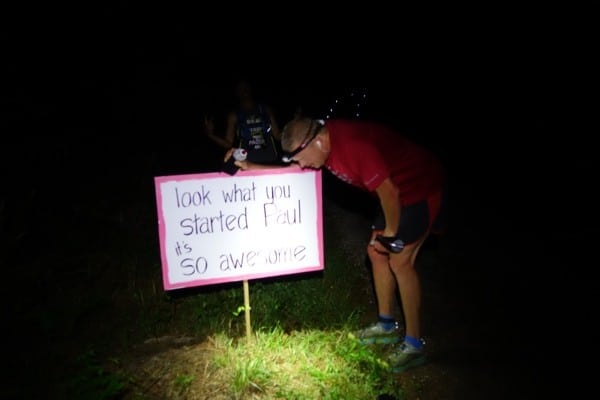
Three miles from the finish, Paul Charteris hunches over a sign feeling less than ‘awesome’ but determined as hell. Photo: iRunFar/Bryon Powell
His pacers busted up laughing. At that moment, the sign struck the group as poignant but unintentionally funny. The Tarawera Ultra that Paul grew into a world-class event was ‘awesome’ indeed—but Charteris didn’t exactly look or feel that way.
Powell told Charteris they needed to get a picture of him with the sign, so Charteris bent over it like a man about to become ill.
“I posed with the sign looking more exhausted than I was,” Charteris recalls, but “after only about a second or two of leaning on it, I almost collapsed—I really was that tired.”
But Charteris knew he needed to harness enough energy for the final 5k, because he was haunted by his outcome at the Western States 100 six years earlier.
And he had to persevere because he didn’t want to let down the countless people waiting to see him cross the finish line. He had become a hometown hero in the region around Rotorua, New Zealand–where the Tarawera Ultra takes place–lauded for creating an event that draws thousands of visitors to the tourist-dependent town and inspires many to gain strength and confidence through trail running.
So Charteris straightened up and got back to the business of zombie-like running through fatigue and a searing pain in his shorts—a pain caused by his decision to jump in one of the trailside lakes to cool off several hours earlier.
“I’m sure it seemed like a good idea at the time” to go for a dip in the lake, says Kerry Suter, one of his Kiwi pacers and a past Tarawera Ultra winner, but “the constant moisture in his shorts led to an all-too-common ultra-distance problem… He had the swag of a man working around an accident involving his dangly bits, a belt sander, and a cup of lemon juice.”
Charteris knew from experience that failure hurts more than temporary chafing, so he soldiered on: “I thought, Oh hell, I’m going to look really, really bad if I can’t finish this thing.”
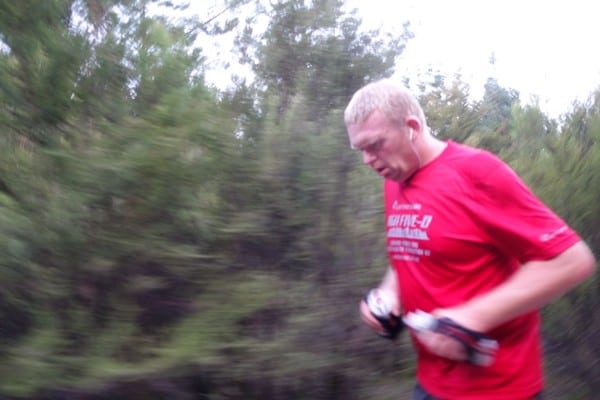
Paul in ‘zombie’ mode, suffering through part of the 2015 Tarawera Ultra. Photo: iRunFar/Bryon Powell
The Race that Charteris Created
The Tarawera Ultra—featuring 100k, 85k, and 60k distances—is widely regarded as a ‘world-class’ ultrarunning event because in 2013 it joined the Ultra-Trail World Tour circuit and began drawing top runners from the United States, Europe, and Asia. It grew from fewer than 70 runners in 2009 to its cap of approximately 1,000 participants in the 2015 edition, which saw Dylan Bowman and Ruby Muir set course records in 7:44 and 9:02, respectively.
The point-to-point ultra starts in a redwood forest in Rotorua, near the volcanic Mount Tarawera, and skirts four scenic lakes while winding over hills and through ferny forests of moss-covered beech trees. It finishes in the small town of Kawerau, where Charteris grew up.
Earlier in his life, circa 2000, Charteris never could have predicted that he would create such an event or develop the fitness to run that far. For a period in his late twenties, the pre-ultrarunner version of Charteris became so mired in depression, failure, and loneliness that he says he contemplated suicide during Christmastime that year.
It’s hard for those who know him as a gregarious, gracious guy to fathom that he ever felt so low. “People think of him as this big teddy bear, and he always has a way of making you feel welcome and at ease,” notes Suter.
But Charteris had to plow through a dark period and forge a new path. If he had not floundered and changed course, then he never would have discovered running and developed the vision for the Tarawera Ultra.
An only child, Charteris lived with his mother through the late 1990s in the economically struggling town of Kawerau. His father died from an illness, exacerbated by depression, when Charteris was 17.
“When I was 11, I arrived home one day to see the words ‘I hate life’ scrawled with white pumice stone on the garden steps,” Charteris revealed in an article he wrote in October 2014 for the High Five-O Challenge charitable site. “My dad was severely depressed, but neither my mum nor I had any idea what do about it. A couple of years later, after my parents’ inevitable divorce, my dad died alone, destitute, and alcoholic.”
The brainy Charteris found his footing in academia and earned a scholarship to study animal genetics at Colorado State University in the U.S. The first in his family to attend university, he left home full of pride and optimism.
But the transition did not go at all as hoped. He was bored with his studies, alienated by the football-and-beer culture, and found himself chronically broke because his New Zealand dollars did not stretch far.
His studies floundered, and ultimately, his academic supervisor “basically took away my key, threw my stuff out the door, and said you can’t come back. He was not a very good people person,” Charteris deadpans. More seriously, he adds, “The thought of going back home, having flunked out of school, was devastating to my self-esteem. I was in a pretty dark spot. I felt so completely alone and isolated, because my life was just going nowhere.”
In his article for the mental-health blog, Charteris went into greater detail about contemplating suicide at Christmastime in the year 2000: “I mulled the thought over and over again, If I kill myself, then people will notice how much I need help. They must notice me—there’s no way they cannot notice—now they’ll see how lonely I am. A month or so later, at a PhD committee meeting, where I was put on academic probation, one of my advisors pulled me aside and said, ‘Paul, you have got depression—but it’s okay, I’ve got it too.’ Thank God somebody had noticed me! Thank God too I have got a ‘thing,’ and it’s called depression. I’m not the monumentally screwed-up failure in life that I thought I was.”
Ultimately, Charteris received some mental help from the university’s health services, but it wasn’t enough to stop his academic downslide. “I was so worried about being labeled a failure in my studies that I simply could not function,” Charteris says. “The only saving grace is I had no money. My only income was donating plasma twice a week. Had I had money to buy alcohol, I’m sure I would have hit that hard.”
Eventually he left the university’s program and moved back into his mum’s home for an extended period, and in that figurative hole he managed to grasp a rope to pull himself out. The rope came in the form of a job at a biotech company in Davis, California.
Moving to Northern California in 2003 marked the beginning of a total transformation for Charteris, who would become known as “Kiwi Paul” amidst the trail-running community that flocked to the town of Auburn to train on the Western States Trail.
An ‘Ah-ha’ Moment on the Dipsea
In the sporty, bicycle-crazy town of Davis, Charteris started to feel and act healthier. He dabbled in triathlons and then, at age 33, stumbled into trail running when he entered the 2005 Double Dipsea—a 14-mile out-and-back race on the famously gnarly trail north of San Francisco by Stinson Beach.
Charteris weighed around 230 pounds at the time and had zero experience with trail running. “It was my epiphany moment, the ‘ah-ha, this is what I want to do,’” he says. “I thought, This is ridiculously good fun, even though I could not walk for about a week afterward.”
After the Double Dipsea, he threw himself into hiking and gradually running, and adopted a healthy diet. “I dropped a ton of weight and started really enjoying these marathon-distance hikes,” he says.
He started making a pilgrimage every weekend to hike around the town of Auburn, about 45 minutes north of Davis, and it wasn’t long before he hooked up with trail runners there. After New Year’s of 2006, “instead of walking in the hills, I was starting to keep up with these guys running in the hills.”
Inspired by their example, he signed up for his first ultra, the 2006 Way Too Cool 50k, and a couple of months later, he finished it in a respectable time of 6:16.
“At the finish, I just broke into tears and fell into [then race director] Greg Soderlund’s arms, blubbering,” says Charteris, smiling but tearing up as he tells it. “It was such a transformative moment, going from being overweight to finishing an ultramarathon.”
An unlikely ultrarunner had hit his stride and found his tribe.
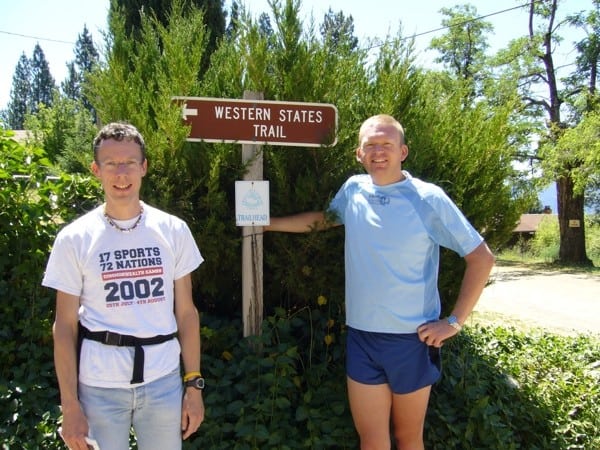
As Paul became immersed in the Western States Endurance Run community, he paced friend Nicholas Ham at the 2006 race. Photo courtesy of Nicholas Ham.
Western States, Take One
Ultrarunners from Northern California wax nostalgic about the mid- to late-2000s. The ultra-trail running scene was taking off then and there, thanks to the media attention around runners like Dean Karnazes, author of the bestseller Ultramarathon Man, and Scott Jurek, who won Western States seven consecutive times from 1999 to 2005. But the sport was still on the fringe and relatively uncrowded. Runners knew each other’s names because they met at races and trained together, not because of the internet.
“Kiwi Paul” became a fixture in the Northern California trail-running community from 2006 until mid-2008. He loved everything about it—and everyone seemed to love him.

Paul and Nicholas during the 2006 Western States 100. Photo courtesy of Nicholas Ham.
“It was very clear that Paul was well thought of and firmly embedded in the local scene,” recalls his friend Jez Bragg, a champion ultrarunner from the U.K. who got to know Charteris in 2008 and went on a camping trip with him the following year.
Adds Bragg’s friend, fellow British ultrarunner Nicholas Ham, whom Charteris paced in the 2006 Western States, “When we joined up at Foresthill and the pacing began, Paul proved to be the most enthusiastic, encouraging, and helpful pacer anyone could wish for. He is simply the best. He is a gentle giant who loves humanity.”
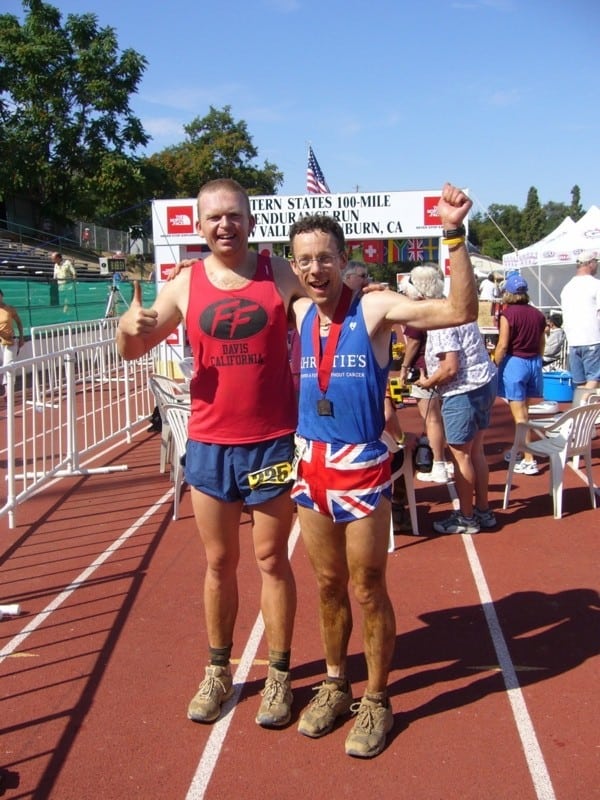
Paul and Nicholas at the 2006 Western States 100 finish. Photo courtesy of Nicholas Ham.
Charteris ran almost every trail race he could get to during those years and became a devotee of the granddaddy of them all: the Western States 100. He volunteered at a Western States aid station, marked the course, paced friends and, most of all, dreamed of running it himself.
“To say I was emotionally invested in the race was an understatement,” he says.
Also around this time, Charteris recalls that his job “was starting to really suck; the company was basically going bankrupt, and we sometimes weren’t even getting paid. I could feel myself, with that pressure, getting drawn back into depression. Trail running helped me through that.”
The chance to run Western States finally came when he gained entry in 2008. But early in that year, he upended his life by quitting his job.
Being a foreigner, Charteris had to leave the country when he left his job, so with little money but a big desire to run, he went on an ultrarunner’s dream road trip: He drove down to the fabled Copper Canyons in Mexico with “Barefoot Ted” McDonald, who became a central character in Christopher McDougall’s 2009 bestseller, Born to Run.
Charteris spent two months running around remote parts of central Mexico with Barefoot Ted and others, becoming steeped in the culture of the ultrarunning Tarahumara Indians and getting into the best shape of his life. He ran the Ultra Caballo Blanco Copper Canyon 50 Mile in a time of 10:23.
Everything, it seemed, was on track for a strong 100-mile debut at Western States. But then devastating clouds of smoke appeared on the horizon.
With a sense of dread, Charteris and his friends who reunited in Squaw Valley for the start of the 2008 Western States followed the news of raging forest fires that moved closer to the trail and dangerously polluted the air. Together, they absorbed the somber announcement that, for the first time in the event’s 35-year history, the race would be canceled.
“We were all devastated by what was unfolding,” recalls Bragg, “but perhaps none more so than Paul, who was 100 percent devoted to the race and everything surrounding it.”
A New Start with a New Ultra
When Charteris moved back into his mother’s house in 2008, “I had no money, no job, and had lost my community of friends,” he recalls. “It was a really tough time for me. A big part of creating Tarawera was for purely selfish reasons, to re-create that community I had in Northern California.”
Charteris focused intently on organizing the first Tarawera Ultra, with an 80k and 60k option, for March of 2009. (He introduced the 100k the following year.) The Western States 100 experience had given him an unshakeable vision for an ultrarunning event that would inspire the growth of trail running in New Zealand and gain international acclaim.
“I wanted it to be a race that people would travel to from all over the world, because I knew if you look at the core assets of the course itself, and its location near a tourist mecca, it’s a world-class combination,” he says. “But trail ultras were absolutely unknown in this part of the country. No one really could understand what my vision was, so getting people on board was a big task.”
The first Tarawera Ultra attracted 67 participants and was a hit to those who ran it. “Paul’s passion to share what he calls an ‘American-style’ ultra in magic New Zealand scenery was plainly a recipe for success,” says Suter, who won the inaugural Tarawera and first met Charteris there.
“We all marveled at Paul’s bizarre [Vibram Five Finger] toe shoes,” Suter adds. “I’d recently read Born to Run, so hearing Paul refer to Scott Jurek and Ted McDonald like they were just some guys he’d hang out with on any given weekend blew me away.”
Right after putting on his first ultra, Charteris had to scrape together enough dollars to get back to Northern California, since all those who couldn’t run the Western States due to the 2008 forest fire earned automatic entry for the following year.
At the time, he was subsisting on leftover Tarawera aid-station food and living in a barely furnished house. He finagled a small bank loan to pay for a plane ticket to California in April, giving himself three months on a tourist visa to train to finish the Western States 100.
Western States, Take Two
Like a kid on summer break who gets to go back to a favorite camp, Charteris returned to Northern California and spent several blissful weeks training. He ran a 50 miler on Mount Diablo, road-tripped and ran with Bragg around Nevada and Yosemite, acclimated for the heat, and circled back to Squaw Valley in peak condition.
The 2009 edition of Western States started exactly as he hoped. “I was having a dream run, just carving through the field. I was so well dialed into that race,” he says, recalling his sub-24-hour pace.
He never imagined that something out of the blue would hit his left leg and render it useless. He felt pain and stiffness on a hill approaching the Devil’s Thumb aid station at mile 47. “I think I tore a tendon in my hamstring there,” he says. “But I just thought my muscles were tight.”
He ran through the pain and limped into Foresthill aid station at mile 62. There, he met up with the legendary Gordy Ainsleigh, the first ever to run Western States in 1974.
Ainsleigh, who had DNF’ed at Foresthill, proceeded to give Charteris some well-intentioned bodywork—“he put me in all manner of bear hugs, but that didn’t really help”—and then sent Paul hobbling off toward the next aid station.
“The field was just streaming by me. I couldn’t run, so I was walking,” Charteris says. The famed river crossing provided temporary relief, so he kept limping ahead and made it through the Green Gate aid station at mile 80.
Then his leg simply ceased to function, as if it had a will of its own and went on strike. Charteris lost mobility around mile 83.
Sitting by the trail while waiting for assistance, Charteris glimpsed the glow of floodlights 17 miles away that illuminated the Auburn track where the Western States finish was taking place.
“The sun was coming up and birds were starting to sing,” he says. “I put my leg up and watched the final runners go by. I just sat there and gave encouragement to everyone. They’d say, ‘C’mon man,’” but Charteris couldn’t move.
Medics carried him off on a stretcher, “and they joked, ‘Why the hell did we get the heaviest runner to haul out of here?’”
Those 83 miles stand as the farthest distance he’s ever reached in a race.
Leaving Auburn for a final time in June of 2009, “I felt I was going back [to New Zealand] on a massive note of failure. I had so many friends waiting at the finish line” in Auburn. “People had signs that said, ‘Go Kiwi Paul.’ It was devastating to not be able to take part in that finish.”
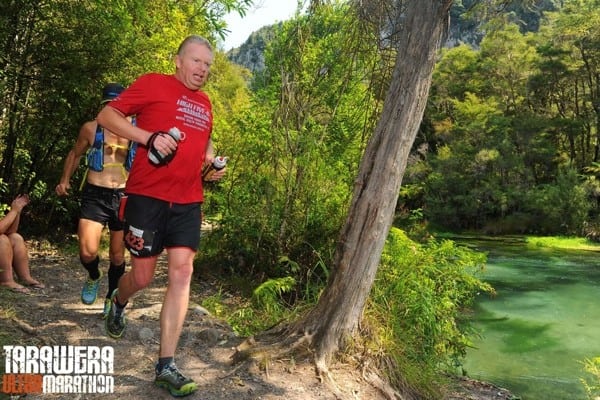
Paul running strong in the first third of the 2015 Tarawera Ultra. Photo courtesy of Paul Charteris/Tarawera Ultra.
Realizing the Vision
Recurrent injury plagued Charteris for the next five years, from 2009 to 2014. He virtually gave up on running, and as his fitness dropped, his weight ballooned.
The 2009 Western States “basically broke me,” he says. “I’d try to do little runs, and actually tried to do some ultras, and I DNF’ed everything I entered.”
Only one thing motivated him and provided an outlet where he could channel his ultrarunning passions and develop relationships with kindred spirits: growing and directing the Tarawera Ultra.
“It was always something to look forward to each year, but also immensely stressful,” he says of Tarawera’s growth through 2013, when the number of entrants steadily increased to 450.
He landed a job as a science writer for a forestry-research institute and used his salary to subsidize the Tarawera Ultra, investing any profit he made into improvements and promotions for the following year’s event.
The biggest—and smartest—investment he made, starting in 2013, was offsetting the travel and entry costs of a select group of competitors from overseas, to attract them to run his race. That year, because of the increased international competition, iRunFar also began providing live coverage of the Tarawera Ultra. This combination of factors marked a turning point for the event because it put the race on the map internationally. In 2013, the elite field included Sage Canaday and Timothy Olson.
Unfortunately, right at the same time when the ultrarunning community focused its gaze on Tarawera in 2013 and 2014, the weather dealt Charteris back-to-back blows. First, the threat of wildfire forced Charteris to re-route the course in 2013. Then, like a bad joke, a raging cyclone appeared offshore just before race day in 2014.
Charteris felt enormous pressure to pull off a successful race, in part because the New Zealand government had granted him $300,000 over three years. The government’s grant came from its Major Events Investment Fund to boost events that benefit the country by promoting tourism and showcasing its scenery and culture. He used part of that money to join the Ultra-Trail World Tour circuit, which promoted Tarawera Ultra globally and attracted more competitors and visitors from overseas.
But the weather forecast for race day in 2014 looked catastrophic. The storm’s winds would whip up waves on the lakes and make the remote aid stations, which volunteers reach by boat, inaccessible.
“I was just devastated I couldn’t give people the race they wanted,” Charteris recalls.
Faced with canceling the event the day before the start, and reliving his personal nightmare when Western States was canceled, an ashen Charteris turned to his friend and right-hand man, Tarawera’s volunteer coordinator Tim Day, of Rotorua.
Day saved the day. At 5:30 p.m., 13 hours before the start, Day mapped out a way to address the cyclone’s safety threats but still hold an event by re-routing and shortening the course to 73k (45 miles). Then Day headed into the dark forest, along with Suter and one other helper, to spend most of the evening re-marking the course.
Just before midnight, “we all had a shot of whiskey to calm ourselves down and prepare for radically altered race,” says Charteris. “We managed to pull it off.”
The Challenge for 2015
The Paul Charteris who greeted runners at the finish line while directing the 2014 Tarawera Ultra was heavy and exhausted. “He looked like crap,” says Powell. Stressed and chronically injured, he had gone “from being a big guy to having a beer belly.”
It was this sleep-deprived and emotionally spent Charteris who took the stage with Day, his volunteer coordinator, for the awards ceremony after the cyclone-shortened race.
The crowd gave Charteris and Day a standing ovation for managing to pull off a race in spite of the storm threat, which brought Charteris to tears. Then Day, standing next to Charteris on a stage and holding a mic, delivered a surprise that caught Charteris completely off guard: Day publicly offered to handle the race-directing duties in 2015 so Charteris could focus on running the Tarawera Ultra himself.
When Day said, “You’re running this next year,” Charteris says his first thought was, “Tim, you wanker, because I thought it would be impossible” given the poor physical shape he was in.
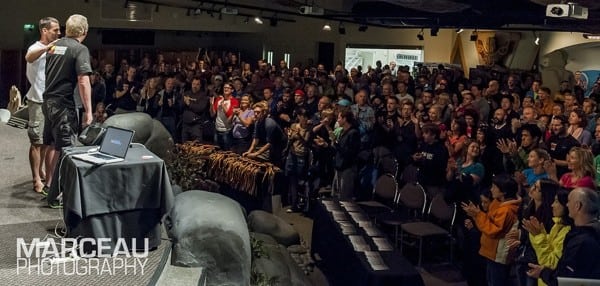
To an emotional crowd at the 2014 Tarawera Ultra awards ceremony, Tim Day (left) issues Paul a surprise challenge for 2015. Tim would manage race-directing duties if Paul ran his own ultra for the first time. Photo courtesy of Paul Charteris/Tarawera Ultra.
But with hundreds in the room cheering and wiping away tears, Charteris was on the spot and could hardly say no.
Day says he decided to present Charteris with that challenge because “I had a strong feeling it would be very good for him mentally and physically.”
And it was. Charteris made significant changes that enhanced his health in the months that followed. He quit his job to devote himself full time to race directing and getting back in shape.
“A big part of why I quit my job was thinking, How can I make a difference in other peoples’ lives? Putting on events that help people gives me the ‘biggest bang for my buck’ in making a difference in the world,” Charteris says.
He also launched a companion race—the Tarawera 50k and Marathon—to be held annually in November, and he moved the date of the main Tarawera Ultra from March to February to reduce the chance of weather-related crises.
By February 7, 2015, Charteris was in good-enough shape to toe the line of his 100k, the farthest distance he faced since dropping out from Western States.
Going the Distance
Charteris was so focused on coordinating the race and hosting friends for the 2015 event that he arrived at the starting line barely ready.
He publicly welcomed the runners, watched ceremonial Maori dancers build the energy at the start line, and then with one minute left in the countdown, he realized his mistakes: he forgot to fill his water bottles, forgot to visit the portaloo, and even forgot to tie his shoelaces.
“I was the worst-prepared runner ever,” he says.
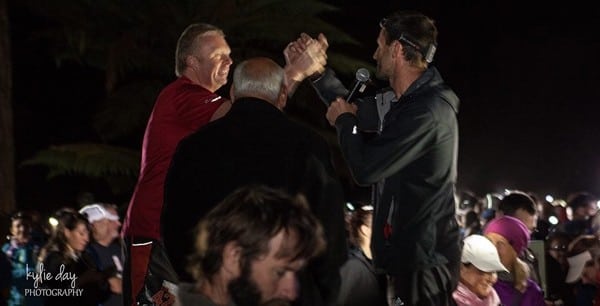
Minutes before the start of the 2015 Tarawera Ultra, Paul (left) and Tim welcome the crowd. Then Paul hands the mic to Tim, who takes over race directing, and Paul joins the crowd at the start. Photo: Kylie Day
Once he started running, he felt elated yet anxious about the event’s organization. Finally he let go of his worries about whether an aid station had enough food or whether the course markings looked perfect.
The crowd thinned out around the 45k point, and he found himself running alone through the dense, verdant forest along Lake Okataina.
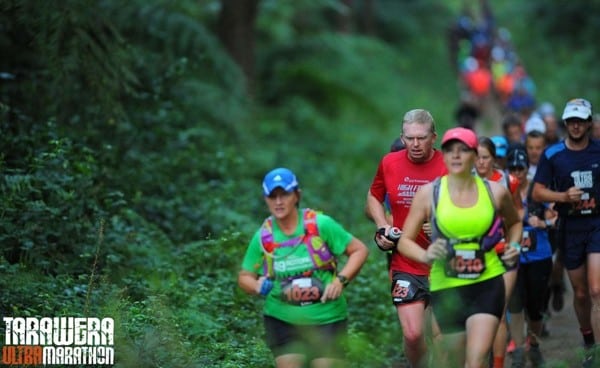
Paul runs amongst the large crowd in the first few miles of the race, before the pack thins out. Photo courtesy of Paul Charteris/Tarawera Ultra.
“I had a little bit of a cry there,” he says. “It hit me that I’m doing something that I created, that I dreamed up eight years ago. It’s this whole sense of pride, of putting on the event for everyone and actually being able to run my whole event.”
He crossed the finish after 16 hours and 15 minutes to the cheers of countless supporters who waited into the night to see him complete his journey in his hometown.
At that moment, says Charteris, “I felt like a first-time ultrarunner again. I thought, Yeah! I got that done, and that was really, really cool.”
[Author’s Note: The 2016 Tarawera Ultramarathon will be held February 6, 2016, and registration for it is now open. The second annual Tarawera 50k and Marathon will be November 14, 2015.]
Call for Comments (from Meghan)
A lot of trail runners around the world have been positively influenced by Paul Charteris, as a friend, as a companion on the trail, and as a race director. It’s time to toast him! Leave a comment to share your story.

Paul triumphant after finishing the 2015 Tarawera Ultra in 16 hours, 15 minutes. He receives a warm welcome, since the finish line is in his hometown of Kawerau. Photo courtesy of Paul Charteris/Tarawera Ultra.
